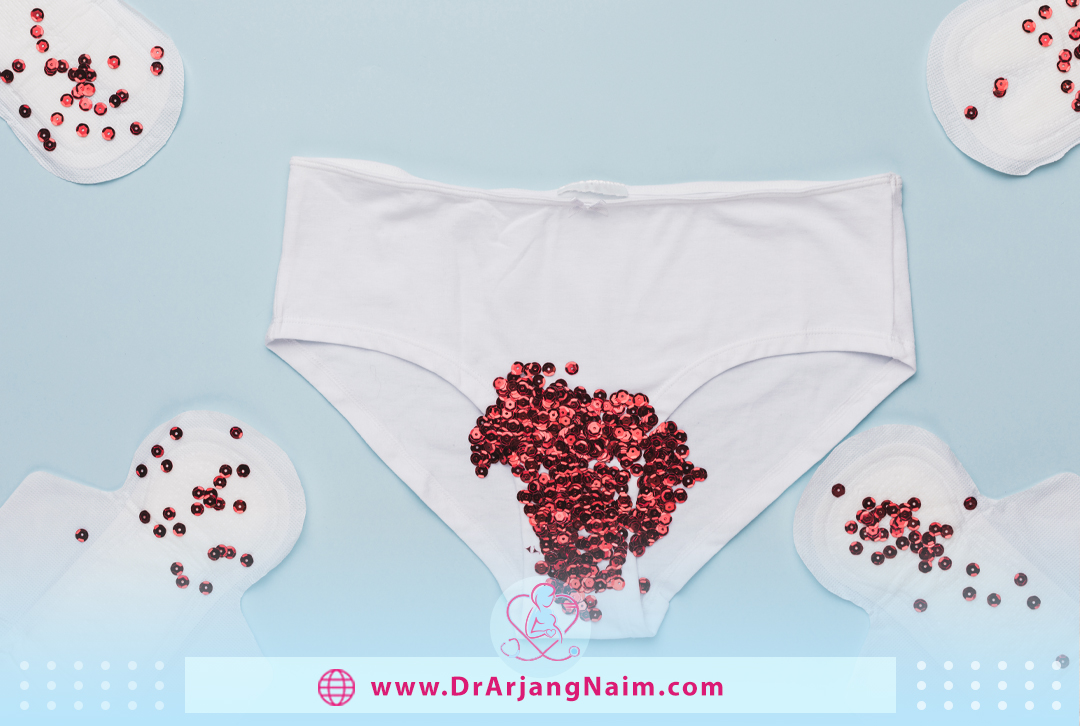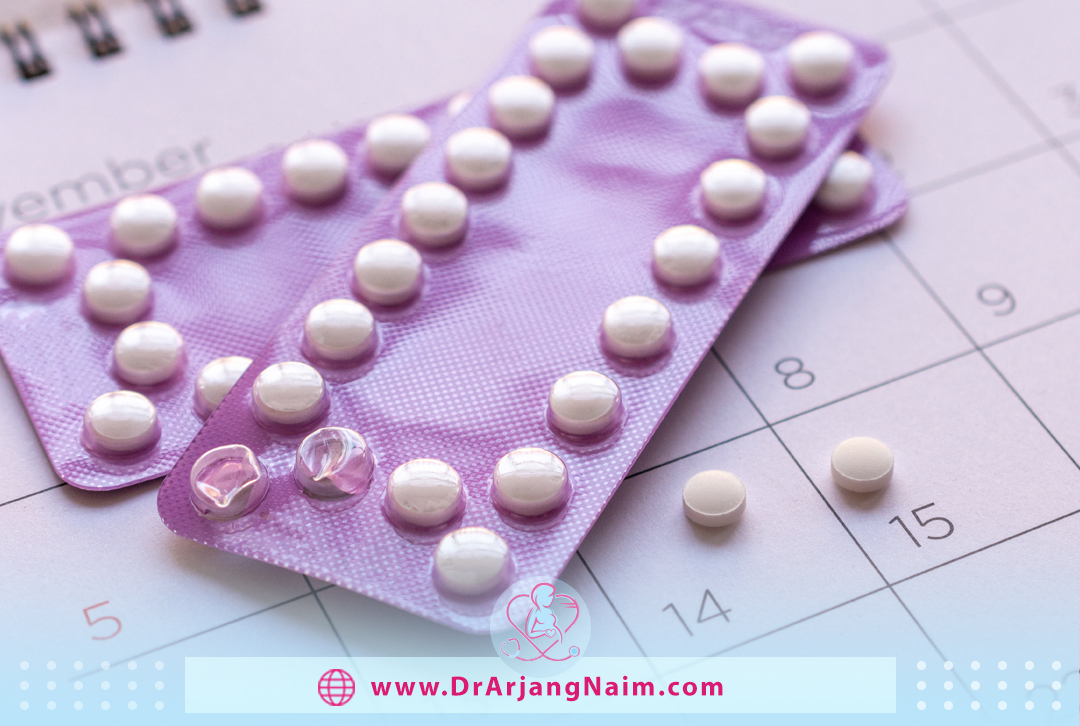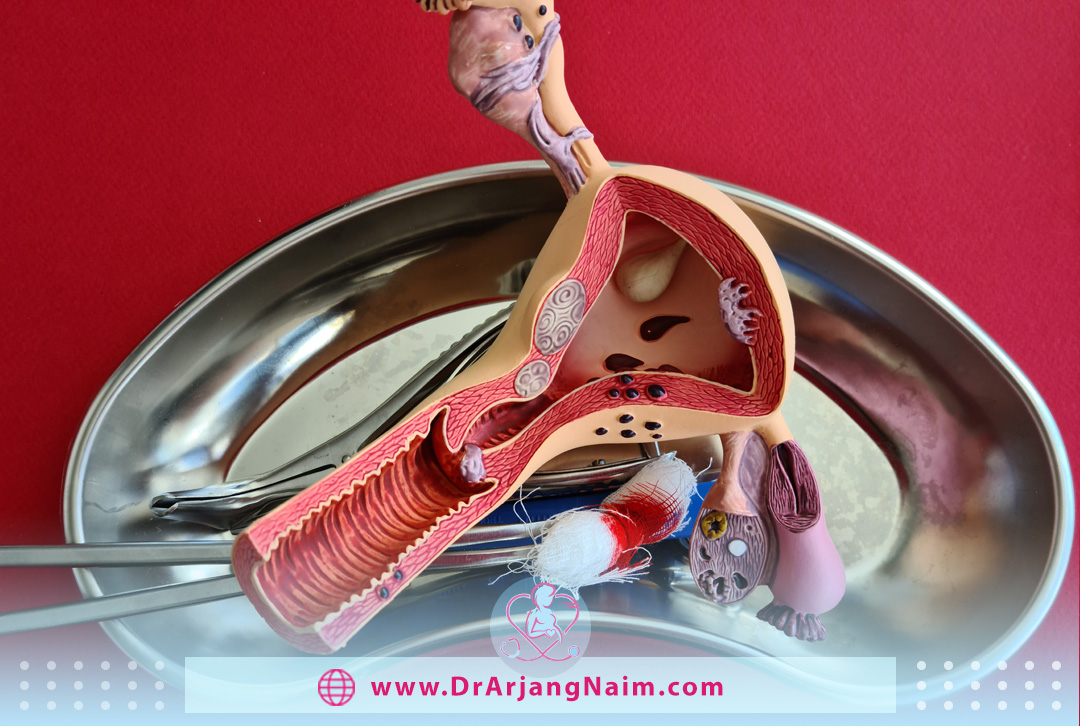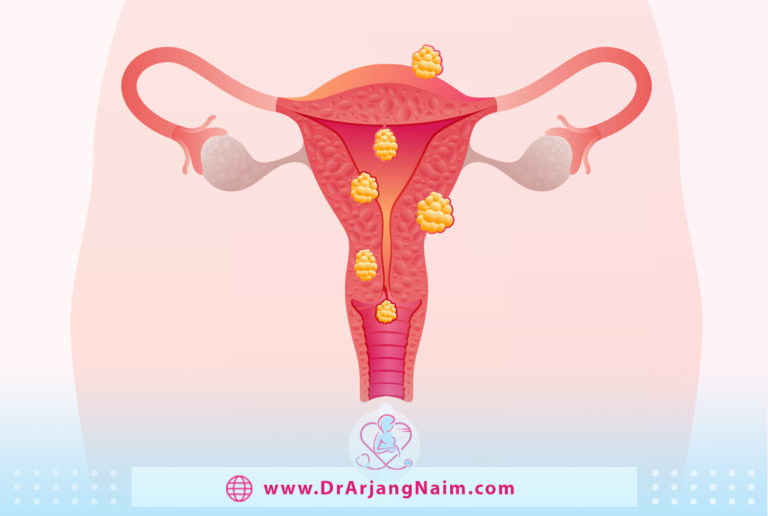A uterine fibroid (also called a leiomyoma) is a growth made of muscle and connective tissue in the uterine wall. This growth is usually non-cancerous (benign). They are the most common female disease affecting up to 70% of women by age 50. leiomyoma causes pain in some people, but not everyone with fibroids experiences pain. Researchers estimate that 30 percent of women seek treatment for pain and other symptoms.
Fibroids can grow as a single nodule or in a cluster. Clusters can range from 1 mm to more than 20 cm in diameter or even larger. These lumps can be formed inside the uterine wall, inside the main cavity of the organ, or even on the outer surface. They can vary in size, number, and location within and on the uterus.
A person may experience different symptoms with uterine fibroids, which may not be the same as another woman with fibroids. Due to the uniqueness of fibroids, the treatment plan depends on the individual.

Signs and Symptoms
Symptoms of leiomyoma may include:
- Heavy vaginal bleeding: Excessively heavy or prolonged menstrual bleeding is a common symptom. In this case, some women develop anemia, also known as low blood count. Anemia can cause headaches, fatigue, and lightheadedness. If heavy bleeding interferes with the person’s daily activities or if she suffers from anemia, the person should see a gynecologist and obstetrician.
- Pelvic discomfort: Women with large fibroids may feel heaviness or pressure in their lower abdomen or pelvis.
- Pelvic pain: A less common symptom is acute, severe pain. This happens when the uterine fibroid undergoes a process called degeneration. Usually, the pain is localized to a specific point and will improve on its own within two to four weeks. The use of pain relievers such as ibuprofen can significantly reduce pain. However, chronic pelvic pain can also occur. This type of pain is usually mild but persistent and limited to a specific area.
- Bladder problems: The most common symptom is the need to. A woman may wake up several times during the night to empty her bladder. Sometimes, women are unable to urinate despite having a full bladder. These symptoms are caused by the fibroid pressing on the bladder, reducing its capacity to hold urine or blocking the outflow of urine.
- Low back pain: Rarely, uterine fibroids press on the muscles and nerves of the back and cause back pain. A large fibroid on the back surface of the uterus is more likely to cause back pain than a small fibroid on the uterus wall.
- Rectal pressure: Fibroids can press on the rectum and cause a feeling of perirectal fullness, difficulty with bowel movements, or pain with bowel movements. Sometimes, fibroids can lead to hemorrhoids.
- Discomfort or pain with sexual intercourse: leiomyoma can make intercourse painful or uncomfortable. Pain may occur only in certain situations or times of the menstrual cycle.
Are fibroids common?
Fibroids are a very common type of growth in the female pelvis, affecting approximately 40-80% of women. However, many people do not experience any symptoms from their fibroids, so they do not realize they have them.
Are uterine fibroids cancer?
It is very rare for a fibroid to undergo changes that turn it into a cancerous or malignant tumor. 1 in 350 people with fibroids develops a malignancy. No test is 100% predictive of detecting rare fibroid-related cancers. However, people with rapidly growing uterine fibroids that develop during menopause should be evaluated.
Can fibroids change over time?
Fibroids shrink or grow over time. They can change size suddenly or continuously over a long period of time. This issue may happen for various reasons, but in most cases, this change in fibroid size is related to the amount of hormones in the body. They can get bigger when hormone levels in the body are high. This happens at certain times in life, such as during pregnancy. In pregnancy, the body secretes high levels of hormones to support the growth of the fetus. This increase in hormones also causes fibroids to grow. If a woman knows she has fibroids before pregnancy, she should discuss it with her doctor because she may need to be monitored to see how the fibroids grow during pregnancy. Fibroids shrink when hormone levels drop, which is common after menopause.
Diagnosis
In many cases, leiomyomas are first detected during an examination. They can be felt during a pelvic exam and can be found during a gynecological exam or prenatal care. The description of heavy bleeding and other associated symptoms may often alert the physician to consider fibroids as part of the diagnosis. Several tests can be done to confirm fibroids and determine their size and location. These tests can include the following:
- Ultrasonography
- Magnetic resonance imaging (MRI)
- Computed tomography (CT)
- Hysteroscopy
- Hysterosalpingography (HSG)
- Sonohysterography
- Laparoscopy

Managing fibroid pain
Pain caused by leiomyomas can significantly affect a person’s quality of life. Many women with fibroids report that it has negatively affected their lives, including their sex lives, performance at work, and relationships. It is essential to talk to the doctor about medical treatment. There are also things women can try on their own that may help manage symptoms.
Home remedies and lifestyle
There isn’t much evidence to support home remedies specifically for fibroid pain, but these treatments provide some relief. Stretching, yoga, meditation, and mindfulness can help manage pain. These activities are not a cure, but they can help change pain perception (through meditation). They can also help correct muscle imbalances caused by chronic pelvic pain. Following a healthy diet and frequent low-impact exercise can promote overall health and help a person feel better.
Over-the-counter therapies
Over-the-counter (OTC) medications and treatments can help manage pain. The doctor recommends acetaminophen (Tylenol) or nonsteroidal anti-inflammatory drugs (NSAIDs, such as aspirin, ibuprofen, and naproxen), which are readily available. These drugs do not cure fibroids, but they can reduce the pain enough that a person can continue with their daily activities.
Iron supplements
The doctor recommends iron supplements if fibroids cause heavy menstrual bleeding, which results in anemia. When iron supplements are taken under the guidance of a doctor to treat anemia, they can make people feel more energetic and stronger, and some pains are relieved.
TENS units
TENS (transcutaneous electrical nerve stimulation) machines can also be purchased at the pharmacy and have been shown to reduce hip pain for some people.
Using a TENS unit involves placing electrodes on the abdomen. The intensity of mild electrical impulses can be adjusted through a battery-controlled unit. Research shows that TENS devices effectively reduce pain from primary dysmenorrhea (menstrual pain), which many people with fibroids experience.
Natural treatments
Natural treatments are effective for some people in reducing fibroids and treating symptoms. Their usefulness depends to some extent on the severity of the individual’s condition.
Nutrition diet
Diet may play a role in uterine fibroids. In particular, people who eat more red meat and drink alcohol are more susceptible. Those who drink one or more daily beers increase the risk by 50%. A diet low in fruits and vegetables also increases this risk. Diets rich in the following may help prevent or slow the growth of fibroids:
- Legumes
- Citrus fruits
- Green tea
- Fish intake (especially oily fish such as salmon and mackerel)
- Lean meats (such as chicken and turkey)
- Green vegetables
Eating foods rich in vitamin D has a protective benefit. Those with vitamin D deficiency have the largest fibroids. Vitamin D can be found in fish such as tuna and salmon and in fortified foods such as milk and cereals.
Weight management
People who are overweight are more at risk of leiomyomas. By maintaining a healthy weight through a nutritious diet and exercise, a woman may reduce her risk of developing uterine fibroids.

Medical Treatment
The two primary medical treatments for fibroids are medication and surgery. Prescription medications are primarily used to manage symptoms but can have significant side effects. Surgery does not always solve the problem because they can recur. Both options have limitations and considerations, but a doctor should be consulted if pain affects a person’s life.
Prescriptions
Some prescription medications can help treat some of the symptoms of leiomyomas, including pain and heavy menstrual bleeding. Examples of medications prescribed to people with fibroids are antifibrinolytic drugs, oral contraceptives, or intrauterine devices. Medications may relieve symptoms in some people, but they have side effects. They don’t shrink real fibroids. Progesterone-based birth control pills cause fibroid cells to multiply.
GnRH Agonists
GnRH agonists and antagonists can shrink the size of the uterus and fibroids and reduce menstrual bleeding. It can also be taken for only three to six months, and fibroids can grow back quickly after discontinuation.
Some doctors recommend treatment with a GnRH agonist such as Lupron before surgery to help shrink the fibroid. However, other doctors argue that giving these medications to patients before surgery may shrink the small fibroids enough to be missed during the procedure, leading to continued symptoms and the need for additional invasive surgeries in the future.
Procedures
Fibroids cause pain through their size and weight or by pressing on other organs and nerves. The only way to remove them completely is surgery.

Hysterectomy
Hysterectomy is the surgical removal of the uterus. This is the definitive treatment of fibroids and can be done laparoscopically. It also has the lowest risk of needing subsequent surgeries. However, a hysterectomy should only be performed if a person does not wish to have children.
Myomectomy
Myomectomy is the surgical removal of fibroids. While laparoscopic myomectomy is less invasive and has a shorter recovery time for patients, it is more challenging for surgeons. Myomectomy is the preferred surgical treatment for people who want to have children. However, additional surgeries are required due to fibroid recurrence in 20% to 30% of cases.
Uterine artery embolization (UAE)
Uterine artery embolization is a non-surgical but somewhat invasive procedure performed in the doctor’s office with intravenous pain relief. In this procedure, a groin catheter is inserted that sprays tiny particles to restrict blood flow to the uterus permanently. Over several months, this will shrink the fibroids and reduce pain, pressure, and cramping. About 15 to 32 percent of people who have UAE need additional surgeries.
The bottom line
If you think you have uterine fibroids or pelvic pain that doesn’t go away, see your doctor for an accurate diagnosis. Symptoms of leiomyomas in women vary and depend on many factors such as size, location, and number.
There are various treatment options for uterine fibroids. The treatment you need depends on your specific case. Diet and lifestyle changes are the first practical plan for treatment. In some cases, a hysterectomy is the best and sometimes the only choice to stop the pain.
Additional questions
1.How long does fibroid pain last?
Fibroid pain takes a different amount of time for each person, depending on the location and size of the fibroid. Some people develop chronic pelvic pain and experience pain throughout the month. Some people may have worse pain during their period.
2.What happens if fibroids go untreated?
Small fibroids usually do not cause problems. But fibroids usually continue to grow and multiply. This can lead to heavy and painful periods, mid-cycle bleeding, frequent urination, chronic back pain, constipation, and reproductive problems.
3.What size fibroids should be removed?
They should be removed if fibroids are larger than 3 cm and cause bothersome symptoms such as pain and heavy bleeding.
4.Where is fibroid pain located?
As with other fibroid symptoms, the location of the pain depends on several factors such as individual anatomy, location, and size of the fibroid.
5.Why are fibroids so painful?
When fibroids are inside the uterus, they can put pressure on the uterine wall and cause pain and pressure in the abdominal area. Ectopic fibroids may press on the bladder, rectum, or spinal nerves, causing back pain and abdominal pressure.
References:
https://www.verywellhealth.com/natural-treatments-for-uterine-fibroids-90069
https://www.healthline.com/health/womens-health/fibroid-pain#outlook
https://www.medicalnewstoday.com/articles/327337#summary
https://my.clevelandclinic.org/health/diseases/9130-uterine-fibroids
https://www.mayoclinic.org/diseases-conditions/uterine-fibroids/symptoms-causes/syc-20354288




